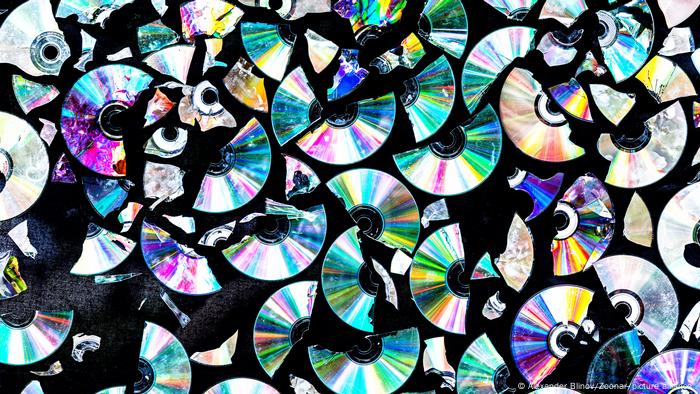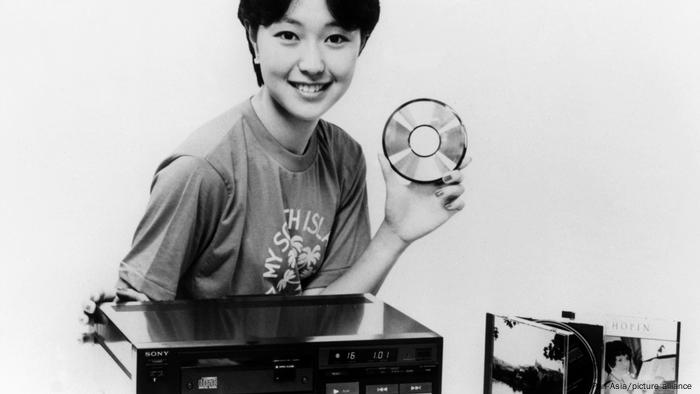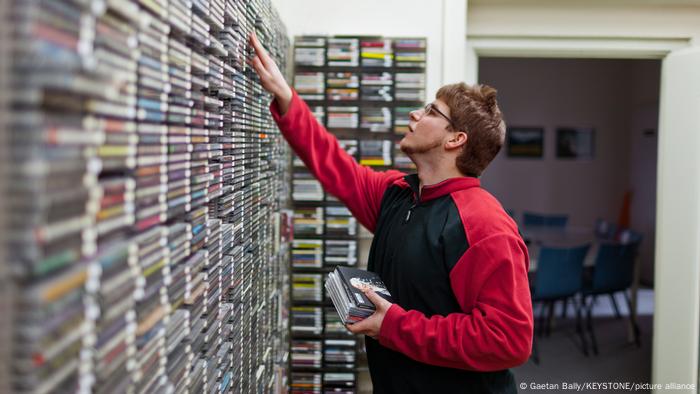40 years of CDs : From listening pleasure to useless trash?
The once revolutionary technology of the compact disc is considered 'old school' today. DW's Silke Wünsch has experienced the rise and fall of the CD firsthand.

It's 1985. We — budding sound engineers — are sitting in the classroom, listening spellbound to the sounds of "Friday Night in San Francisco" — the legendary guitar album by Al di Meola, Paco de Lucia and John McLaughlin, among the best guitarists in the world at the time.
The sound is crystal clear, the tones bubble out of the speakers. Although the music is playing at "room volume," we have the feeling we can hear every note, every finger stroking the strings. We even think we can hear the breathing of the musicians.
What we don't hear: The hiss from a tape or cassette, or the scratch and crackle of a vinyl record.
It was the first acoustic encounter with a CD for most of us and a revelation for our young sound-engineer ears.

Sony's introduction of the CD transformed the way people listened to music
From Beethoven to ABBA
The compact disc had been around for some time; there was just a long argument about how much music should be pressed onto it. Finally, it was agreed that the playing time of a CD should be long enough to fit one of the world's most famous classical works — Beethoven's 9th Symphony in Wilhelm Furtwängler's 74-minute version.
In 1981, the CD was presented at the Berlin Radio Exhibition. The first industrially produced discs rolled off the production line on August 17, 1982, and legend has it that the ABBA album "The Visitors" was burned on them. Perhaps it was also a recording of Richard Strauss' "An Alpine Symphony," conducted by Herbert von Karajan, who had outed himself as a big fan of the CD from the very beginning, describing it as "a miracle." Another legend says it was waltzes by Chopin that were pressed onto the first CDs.
Champagne for all!
A short time later, Sony and Philipps launched the first freely available CD players on the market for around €1,200 — unaffordable for many people at the time. Both companies had worked together on the development and were soon able to sit back and relax, because the CD business was going through the roof.
In 1984, 3 million CDs were sold in Germany alone; in 1989, the figure was 54 million. And the price wasn't cheap: A CD cost 30-40 German marks (about €15-20), more than twice as much as a long-playing record. And this success came despite the fact that nobody knew how long the data on the discs would last.

The author traded in her crackly White Album vinyl for a CD version
They multiplied like weeds
Over the years, CD players and CDs became more affordable, record stores had to rearrange as music fans started to trade in their vinyl collections for CDs — just like me. My favorite records had become so crackly that I was eager to enjoy this music without noise for a change. And without turning them over!
I spent horrendous sums on new Pink Floyd and Prince CDs, and on The Beatles' White Album — the most important record of my life to this day. I bought jazz and classical music, and more and more pop, rock, soul and funk. Next to my record shelf, a CD shelf sprang up and quickly grew, spreading like weeds through the living room. Records and turntables collected dust and ended up in the basement.
It took on almost absurd proportions when I changed careers and became a music editor. The record companies, many of which were based in Cologne at the time, were very generous with promotional CDs. Once a month I went on a "foray" in Cologne, and when I came home with my bulging backpack full of new releases, there were still two to four packages in front of the door. My collection exploded — it needed its own room.

A CD shelf not too unlike the author's
What do you do with 40,000 CDs?
My CD collection grew to over 40,000. And it had to move with me three times. The curses of my movers echo to this day. But there's a certain style about walking along a five-by-two meter shelf looking for the CDs for a party, a music show or just a music evening with friends. It has less style when you find forgotten boxes with hundreds of old promo singles in basements and garages — where to put them?
And what about throwing them all away? That's a job in and of itself, what with separating them all properly for recycling: plastic covers in one bin, paper booklets in another, the CDs themselves in yet another.

Some of the author's favorite CDs, bought in the 1990s
So, it's better to give them away or put them out on the sidewalk for passersby to take them — or make art out of them. Probably the most creative solution was to cover the ceiling of our office in the Deutsche Welle broadcasting center with CDs. My colleague and I used every free minute to stick the silver discs to the ceiling with adhesive tape. We also forced our trainees and interns to do this — after all, they had to learn that the job of a music editor also entails disposing of old promotional CDs.
My job changed again and I decided to part with my collection — as painlessly as possible. This was not easy. Because even used CD albums with pop and rock classics are virtually worthless.
Finally, before my last move, someone who can be safely described as a total music nerd took my collection. My remaining CDs are probably limited to about 1,000.
Old school is fun
Even today, I still play music at parties from time to time. People look at me in disbelief when they see the luggage I arrive with. Two DJ CD players, a mixer, two thick folders with burned CDs and a wooden box with original CDs. Completely old school. Other DJs use laptops, have their music on a big hard drive and play it with software. Sounds tempting — just like listening to music via Spotify & Co, which has been killing off the CD for years.
Even more tempting than Spotify playlists, however, is the vinyl record, to which I have once again become addicted after parting with my CD collection — as have numerous music fans around the world. In 2021, for example, more vinyl records were sold in the US than CDs for the first time since 1991. And at these prices: €30-40 for a 180 gram vinyl record is standard. A record today costs more than twice as much as a CD — this sounds familiar…
So I'm right on trend: After I bought my beloved "White Album" by The Beatles as a new CD in 1991 because the old record had scratches and cracks, I now have it on my record shelf in a new vinyl special edition.
This article has been translated from German.

THE TAPE RECORDER TURNS 80
The first tape recorder
When electrical equipment manufacturer AEG introduced the Magnetophon K1 in Berlin in 1935, more than five decades had passed since Thomas Edison's groundbreaking phonograph. Many had explored the idea of recording sound electromagnetically, however it was the development of a unique tape head, in concert with a plastic tape coated in iron powder, that proved the breakthrough.
12345678910111213
No comments:
Post a Comment